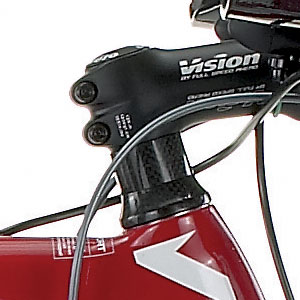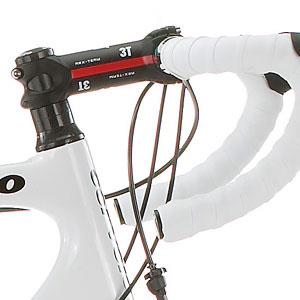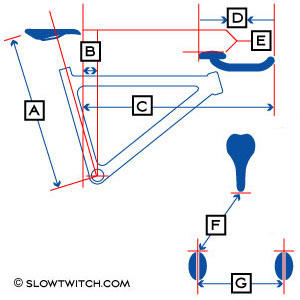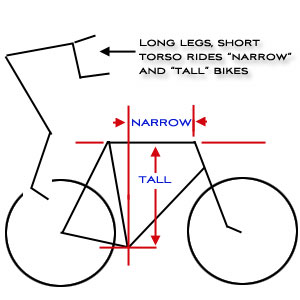Remote bike fit for retailers

Retailing is hard. I've never been a retailer and by gummy please be a pal, and put me out of my misery if I ever try it.
Part of what makes retailing so hard is all the hats a retailer has to wear: financier and bookkeeper; mechanical wizard and repairman; employer; community advocate; champion salesman; ergonomist; and merchandiser.
Let's talk about those last two items. Ergonomist. What does that mean? One dictionary definition is: The applied science of equipment design, intended to maximize productivity by reducing operator fatigue and discomfort. It's a fancy word for bike fitter or, for the purpose of today's primer, a bike "setter upper" as relates to how the bike will be presented on the showroom floor.
Then there's the retailer as merchandiser. When you broach the subject of how built bikes ought to be presented, you can see the confluence of ergonomics and merchandising.
Earlier I wrote about how to "ballpark fit" a rider to a tri bike knowing very little—in fact, only his seat height. Now let's translate that knowledge into how a bike ought to be presented by a retailer on his showroom floor.
Let's say a retailer carries Cervelo and Cannondale. He gets his P2s, 3s and 4s, and he gets his Slices. They all come in boxes, they must be assembled and placed on the floor. They must be ready to test ride.
Let me make life a little easier for retailers everywhere. Cut off all your steer columns, right out of the box, so that they terminate between 7cm and 8cm above the top of the head tube. This solves several problems, most importantly relieving you of any temptation to perch the stem so that the stem's bottom sits more than 4cm above the head tube terminus (that's 4cm total, counting the headset top cap, of "stuff" between your head tube top and the bottom of the stem). If your rider is positioned by you with more stack than this, he's on the wrong bike or, at the very least, he's on aerobars that don't match that bike for that rider.
Also, when you do build this bike up, if you have the steerer pre-mitered you won't have a tube sticking up from the stem, pointing toward the user's face, with all the appearance of a device sold by another sort of retailer.
Why this distance: 7cm to 8cm? Most stem clamps are 4cm in length (a very few are 5cm, some are as short are 3.5cm). So, 4cm or so of the steerer passes through the stem. That 4cm, plus 2cm of 2008 factory Cervelo headset top cap, plus a max 2cm of spacers under the stem, gives you 8cm of steerer.
So mister bike assembler, after you bang on the crown race seat, and stick the fork inside the head tube, measure 8cm of steerer out from the head tube top, and cut. If it's me, it's more like 7cm of steerer. Just remember it's going to be a different for every size of bike.
Consider the two photos of the Cervelos here. The uppermost photo is Cervelo's studio shot of its P2. To my eye, that doesn't look like Cervelo's factory headset top cap, rather a shorter one that's only 1cm or maybe 12mm tall. Also, the Vision stem is almost certainly about 4cm tall, so, that steerer is cut about 7cm or 7.5cm above the head tube top. That's plenty. If you can't make the bike fit with all that mess under the stem, the bike's the wrong size; or those Vision clip-ons ought to be replaced by hi-rise armrests such as on a Profile T2; or it's the wrong bike for your customer; or you're a bad fitter.

Now, let's consider the pic of the R3 adjacent. That's a road race bike, of course, and this stem clamp might be closer to 3.5cm in height. Again, 12mm or so of headset top cap, 2cm of spacers under the stem, 5mm of spacers over the stem, the steerer is probably 2mm shorter than the stack just tabulated (so that the head parts can properly compress), and you have a steerer that is 7cm above the head tube top. No need for more than that—certainly not on a road bike, and why do you need more on a tri bike? if this amount of steerer isn't enough, this isn't the right bike for your customer.
Now, when you set these bikes up on the floor, it's going to be easier for your test riders to enjoy the bike if you have it set up more or less ready to ride. In our experience, if you place the saddle at 79° of seat angle, it's hard to miss. Some riders like the seat angle a little steeper, some like it less so, but the variance is small (1.5cm of saddle movement in either direction).
How do you measure this? From the bottom bracket through the center of the saddle's rails, with a digital angle finder. A 48" Smart Tool, or the cheaper (and better) version sold at Sears for $100 or so.
Incidentally, this means that in almost every case, it's the forward of two seat post options: the forward hole on Cervelo's seatposts; the forward position on Felt's 2-position posts; and the brand new really steep post out by Orbea (no need to ever take possession of Ordus and Oras with the standard post, you should only need either of the two steeper posts now available). It means the Specialized Transition only with the straight post, not the set-back post; and it means Trek Equinox TTXs with the post always turned around forward.
Set the saddle at a reasonable height given the bike's size. You could do worse than adding 20cm to the size of the bike. So, 78cm of saddle height on a 58cm bike, measured BB to saddle top, halfway between the front and back of the saddle. For a 55cm bike, maybe 75cm of saddle height. A 68cm saddle height on a 48cm bike, and so on.
Obviously, this is problematic on certain Scott and Kuota bikes, where the seat mast on the bike is cut to fit. Steerers I would cut in advance; seat masts I would not.
You've got the seat angle determined, as well as the seat height. What about the armrest elevation distance between the saddle top and the armrest top? Here's a formula for you, with "D" a placeholder for the saddle height, and "C" the armrest drop (the value you're looking for):
C = .005Dˆ2 + .0075(seat angle)D – .7775D – 1.5cm
In layman's terms it means, at 79° of seat angle, for 80cm of saddle height you'd use 15.5cm of armrrest drop. For 76cm of saddle height you'd use 13.5cm. For 74cm it would be 11.5cm; at 72cm you'll want to use 9.5cm, and for 70cm 7.5cm.
It's fine to end up with a deeper drop than this once you've fit your customer to his bike, but this amount of drop is a good starting point for floor display. If this sounds like a lot of drop to you, consider reordering your thinking about tri bike fit. If your experience is that your customers won't like this much drop, it's because you've been setting them up too shallow, with cockpits too long. The reason this amount of drop is sensible in your pre-built, floored, display models is because you've done the complementary things that make this drop proper: the bike is set up appropriately steep; and you're about to give it the right amount of cockpit distance.
Now you only have left the cockpit distance to worry about. Yes, the bike comes with an OE stem. But I would not automatically build the bike with this. I'd choose a stem about 2cm shorter than the stem I'd choose for a road race bike of the same size. But this has to do with steering and handling more than fit.
The stem plus the aerobars ought to be positioned so that the distance from the saddle nose to the ends of the extensions is the same as the saddle height you've chosen. If you're setting up a 58cm bike on the floor, and the saddle is sitting 78cm from the BB, the distance from the saddle nose to the ends of the extensions (not counting the bar end shifters) ought to be 78cm also. This assumes the aerobar extensions are an appropriate length, which often means cutting a bit off of what comes from the factory.
Now, if you take my advice and floor your bikes this way, and you're finding it hard to get the bikes to conform or obey, consider the bike lines you carry. All the above will be easy with Cervelo, Felt, Giant Trinity Alliance, QR Kilo and Tequilo and Jamis. With Trek, Specialized, Cannondale and Scott, you can still make this work, though you might want to sit that saddle at more like 78 degrees of seat angle, and the aerobar armrests will sit 1cm higher than the guidelines posted above.
Why would you set your Cannondales and Scotts up this way? Two reasons. First, because they're built to be ridden slightly shallower. But there is another reason. Your leggier customers will fit these bikes just through moving the saddle forward a bit. Yes, the cockpit will be shorter than the seat height if all you do is move the saddle forward—it violates the "rule" of cockpits that match seat heights. But this is typical of long-leg, short-torso riders. This is why Cannondale, Trek, Scott and Specialized are great complementary brands with Cervelo and Felt: leggy, short-torsoed riders are a hard fit on long and low bikes like Cervelo and Felt. Carrying Cervelo and Felt only in your store means you miss having that correct bike for these alternate morphologies.
If you're a bike designer, or a product manager for a bike company, the dimensions I'm listing above are pretty much "default" for the various saddle heights described. When you choose an aerobar to spec, or when you design a new mold, think about the fit coordinates your customers will choose if a competent fitters aids them. Design and spec your bikes accordingly.




Start the discussion at slowtwitch.northend.network